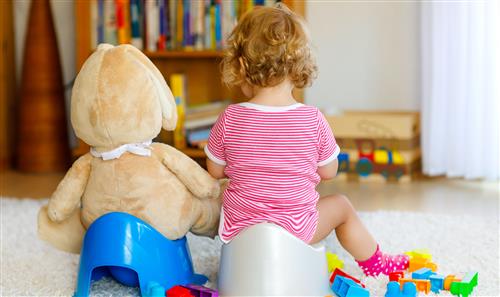-
Tips and information
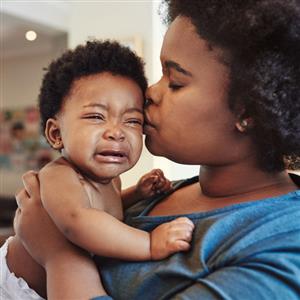 Children don't come with instructions! Early Childhood Family Education (ECFE) offers high-quality programs designed to help you in your parenting efforts. Licensed parent educators from the Anoka-Hennepin School District's ECFE program are happy to share parenting ideas and tips or point families in the right direction of community and support resources if necessary.
Children don't come with instructions! Early Childhood Family Education (ECFE) offers high-quality programs designed to help you in your parenting efforts. Licensed parent educators from the Anoka-Hennepin School District's ECFE program are happy to share parenting ideas and tips or point families in the right direction of community and support resources if necessary.
Do you have a specific parenting question or concern that you would like a parent educator to help with?
Articles and resources for families
-
How nature makes kids calmer, healthier and smarter
*Learn about the Anoka-Hennepin Early Childhood Family Education (ECFE) outdoor spaces for classes and Playtimes at the end of this article.
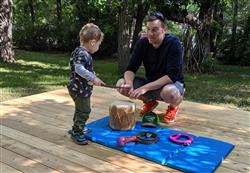 In the midst of families’ busy schedules often filled with sports and other activities, it is sometimes often hard to fit in time to just play outside or visit a park.
In the midst of families’ busy schedules often filled with sports and other activities, it is sometimes often hard to fit in time to just play outside or visit a park.Did you grow up, freely playing outdoors and climbing trees? If you did, you’ll likely agree that you want your child to enjoy those experiences as well.
Today, however, many children do not have a backyard or anyone to play with. And then, as a parent, you worry that you have to stay outside to keep them safe - but what about dinner or those emails that you wanted to answer?
So many children spend much of their time indoors. As a result, by the time a child is in elementary school, given a choice, they actually prefer to stay inside.
Our grandmothers were right: Kids need fresh air and exercise. We all do. Research shows that children (and adults!) who spend time outside in nature are:
- Calmer - Fresh air soothes the senses. This is particularly important for children who are more sensitive to stimulation.
- Happier - Studies show sunshine, fresh air, and physical activity encourage good moods and reduce tendencies toward depression.
- Healthier - Children who don’t get enough time outdoors can be vitamin D deficient, which affects healthy eye function.
- Better students - They have longer attention spans, less frustration, and do better in school. It’s all that oxygen to the brain.
- More creative - Outdoor play is often less structured, so kids exercise their imaginations as well as their bodies.
So what’s the answer to our nature-deprived lives? Getting outdoors! We know that usually kids won’t be able to be outdoors without parents. So parents need to get outside, too.
Anoka-Hennepin Schools ECFE teacher at Sorteberg Early Childhood Center, Jessica Fabb, says, “For a young child, everything is new—even the tiniest things are interesting and exciting.” Fabb teaches classes in the outdoor classroom at Sorteberg, which is full of natural possibilities for adults and children to explore together.
Here are two quick ideas for outdoor play from Fabb:
- Set up an outdoor space that is inviting, and spend time there with your child. A sandbox, wading pool, swing, climbing structure or garden will keep your child entertained for hours. If permanent structures aren’t possible, think temporary: A tablecloth tent or a bucket of water with funnels and cups, or a shovel to dig a hole you can later refill.
- Spend time as a family in nature -- hiking, playing tag, biking, or simply walking together to a local park or just around the block. It allows your family to regroup and get back in sync. It makes wonderful memories.
Lastly, “Don’t forget to ask open-ended questions when you are outdoors with your child,” says Fabb. “You may just be surprised with the enjoyment you both have while being in nature together.”
If you're stuck for ideas, here are the additional suggestions that Fabb shares for family outdoor fun.
- Paint sidewalks, the house, rocks, and trees with water! Give each child a cup or small bucket of water and a brush. Then, just let them go to town painting. It's cheap, easy, and fun. And it will entertain them for a long time.
- Bring some of your child's favorite toys outside: dinosaurs, blocks, vehicles, etc. Playing with them among the grass and plants brings a whole new element of fun to their play.
- Fill a plastic storage bin with water and different cups, small plastic containers, or pitchers. Even the smallest bin or bucket of water will keep my preschoolers and toddlers happy, splashing, stirring, and pouring for hours. You can even add a few drops of food coloring to make the water your child's favorite color.
- Also with water, make "soup" with water and any nature items found in the yard...twigs, leaves, pinecones, etc. Mix and stir then pretend to have lunch.
- On a sunny day, use chalk to trace your child's shadow on the driveway. Make several tracings, and then see if your child can fit his shadow back inside the tracing.
- Chalk is also a great way to draw a road or racetrack on the driveway you can run, bike or scooter on. Make traffic signs to stop and go. A smaller track can also be used for toy cars and trucks.
- Go on a nature hunt with a magnifying glass. Have your child look closely at bugs and plants.
- Take it outdoors! Enjoy a snack and read stories on a blanket on the grass instead of indoors. If it's a book about nature or birds, take time to look around or listen to see if you have some of the same things in your area.
- Use outdoor pillows and a sheet or blanket to create a fort, a castle, or a tent - creating a magical space that they will want to live forever. You don't have to be a child to enjoy a blanket fort!
- As the sun begins to go down, use flashlights or glow sticks to explore your yard.
- Have a carwash with trikes or scooters with soapy water and sponges.
- Visit one of the many nature centers in the metro area - many have free activities on weekends. (Wargo Nature Center, Springbrook Nature Center, Eastman Nature Center, or Coon Rapids Dam Visitor Center)
- Create a nature scavenger hunt and have your child look for something that flies, something that crawls, something green, something soft, etc.
*Anoka-Hennepin Schools Early Childhood Family Education (ECFE) is fortunate to have two outdoor spaces for classes and Playtimes - Riverview Early Childhood Center and Sorteberg Early Childhood Center.Riverview Early Childhood Center which is located in Brooklyn Park has a great outdoor playground as well as a greenhouse and garden area which families enjoy in a number of classes throughout the year. Sorteberg Early Childhood Center is located in Coon Rapids and has a beautiful outdoor classroom that is utilized year-round ECFE classes as well as Family Playtime sessions.
Stay Connected!
Subscribe to emails to learn about opportunities to attend classes and activities, preschool information, and parenting tips and ideas. And, make sure to follow us on Facebook and Instagram to get the latest information, promotions, and other exciting announcements. -
Catch your child doing something right
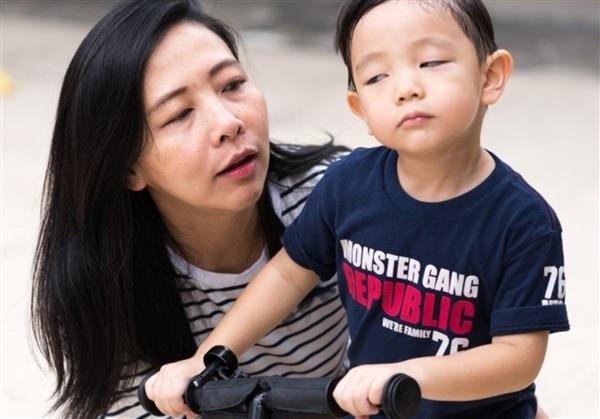 You could probably find negative things to say to your child all day long. All of them "deserved" and none of them effective in helping your child want to cooperate.
You could probably find negative things to say to your child all day long. All of them "deserved" and none of them effective in helping your child want to cooperate."Aren't you ready yet?... You'd lose your head if it wasn't on your shoulders... How many times have I told you?... Pick up your things... Stop that right now... You're wearing me out... Don't start with me... Leave your sister alone... Are you listening to me?... I said NOW!... What part of NO don't you understand?"
This critical voice comes from fear. That may seem odd since what you probably feel is frustration or annoyance. But it does come from fear, meaning fear that your child isn't growing up okay, or won't turn out okay, because either you or your child isn’t good enough.
That’s your inner critic talking. Its job is to keep you on your toes, fending off any possible bad outcomes. Unfortunately, happiness is not in its job description. And regardless of what your inner critic tells you, it isn't always right. Either about the ultimate outcome or about what you should do right now.
So when you open your mouth to criticize, take a deep breath and reassure yourself: "They're acting like a kid because they ARE a kid." Then, start over. Find a way to say what you need from your child, but with love and encouragement.
No matter what your child does, you have a choice about how you react. You're not a saint. No parent is, and no parent is empathic all the time. But when we pay attention, we usually find we can eliminate much of the drama and upset in our homes just by managing our own emotions.
Even better? Our child gives us the benefit of the doubt on those less frequent occasions when we do get upset.
Here's the news blast. Finding fault with kids doesn’t help them change. (Not surprising, really. Does it help you change?!)
Children, like other humans, grow and change when they feel loved, accepted, appreciated, and respected. That lets them drop the need to defend themselves. It makes them want to cooperate. It allows them to learn and grow!
So if you want your child to be their best self, catch them doing things right all day long -- including all those things that you think it's about time she did right!
- Notice all progress in the right direction, even if it isn't perfect. ("Thanks for picking up your things with only one reminder! I really appreciate how you got up and did it.")
- Instead of evaluating her as a person ("You're a good girl!"), say very specifically what you appreciate. ("I like how you apologized to your friend. That took some courage.")
- Enjoy your child for who they are ("I loved watching you play soccer today!") rather than trying to make them into someone better. ("You should have played harder so you could have scored a goal.") Think they could do better? That's the coach's job. Your job is to keep their love cup filled so they can blossom.
- Find a way to see your child positively. Things we see as bothersome are the flip side of strength. ("I love that you have so much energy!")
Imagine this as the soundtrack of your child's day:
“I love how cheerful you are in the morning. It makes me happy to wake up."
"I noticed how nice you were to your sister last night."
"I love it when you brush your teeth without being reminded."
"I notice you're working so hard on that."
"I know that's disappointing, but I see how you keep trying. Soon you'll get it every time."
"Don't worry, Honey, nobody bats 1000."
"I loved watching you pass the ball."
"Hey, you figured that out yourself!.
"You're such a great hugger and snuggler."
"One of the many things I love about you is how you always give the dog lots of attention."
"How did I get to be so lucky as to be YOUR parent?"
Wouldn't that help your child want to be his very best self?
What we pay attention to is what flourishes. Every time you appreciate your child, every time you love something about them, you are giving them the clear message: More of this, please. They will grow accordingly.
Adapted from https://www.ahaparenting.com/read/catch-your-child-doing-something-rightLicensed parenting educators are happy to share parenting tips or point families in the right direction of resources available. Anoka-Hennepin Community Education provides Early Childhood Family Education (ECFE) resources for families with children ages birth to grade three, year-round.
Stay Connected!
Subscribe to emails to learn about opportunities to attend classes and activities, preschool information, and parenting tips and ideas. And, make sure to follow us on Facebook and Instagram to get the latest information, promotions, and other exciting announcements.
-
Complimenting your child
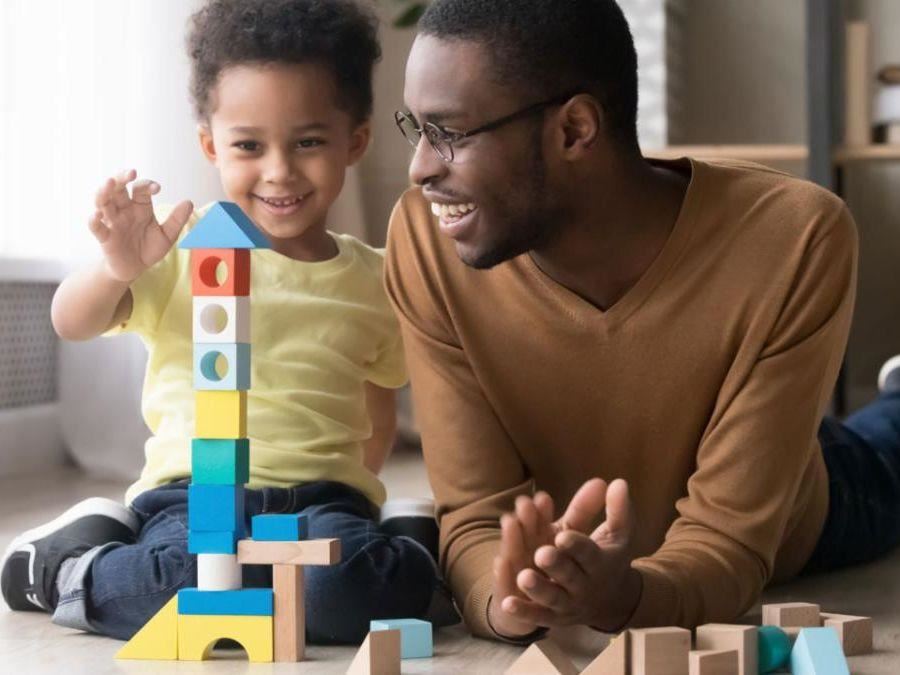 When it comes to the little person in your life, try using compliments that reflect self-esteem and confidence. From appreciating their creative side to how far and fast their strong legs will carry them, here are 15 nice things to say to your child today (and every day).
When it comes to the little person in your life, try using compliments that reflect self-esteem and confidence. From appreciating their creative side to how far and fast their strong legs will carry them, here are 15 nice things to say to your child today (and every day).1. I love how hard you worked hard on this project, and how you stuck with it even when you got frustrated. Focus on how they overcame the challenge and what they accomplished.
2. You make the world a better place just by being in it. And if anyone thinks otherwise, it’s their loss!
3. Don’t let mean kids tell you what to think of yourself. Your self-esteem belongs to only you.
4. I’m so happy you’re in my life. After all, wouldn’t you want to hear that from someone you love?
5. Isn’t it great that your strong legs can help you run super fast? Praising the things a child can do with their body instead of noticing how it looks will help them appreciate, and strive for, a healthy lifestyle.
6. I love the color combo you’ve got going on today, it’s very creative! Nice things to say to your child doesn't have to focus on just looks. Compliment your child on their outfit when you focus on their creativity, rather than how pretty or handsome they look.
7. You are a kind person. Compliments for children that focus on kindness, courage, and honesty will go far in building self-esteem.
8. I’m really impressed with how you solved/built/created that. Can you show me a thing or two?! Praise your child for their critical thinking and problem-solving prowess, and nurture their interest in all things STEAM.
9. I think you are a great leader. One of the best things you can do for your child is showing them that being a leader isn’t just “being bossy.”
10. I am proud of you. Because kids need to hear this from their parents.
11. Just be yourself. It’s enough. Children today are being told more and more that they aren’t enough, and it’s time to break the cycle and instill confidence.
12. Your ideas are important, and I want to hear them. Children need to know their ideas are awesome and worth sharing.
13. Your bright smile shows me how happy you are. Your child usually smiles for a reason, and when you notice, it’ll make them even happier.
14. Your inner beauty and kindness shine through your personality. Your outer beauty is an added bonus.
15. You’re strong, you’re smart, and you can change the world. Because they can and they will!
Adapted from http://redtri.com/compliments-you-need-to-give-your-daughter/Licensed parenting educators are happy to share parenting tips or point families in the right direction of resources available. Anoka-Hennepin Community Education provides Early Childhood Family Education (ECFE) resources for families with children ages birth to grade three, year-round.
Stay Connected!
Subscribe to emails to learn about opportunities to attend classes and activities, preschool information, and parenting tips and ideas. And, make sure to follow us on Facebook and Instagram to get the latest information, promotions, and other exciting announcements. -
Cool ideas for HOT summer days
Get set to beat the heat this summer with these super cool activities!
Water activities for kids are always a hit in summer! Add in some cool ice activities and you’re bound to have a super cool summer!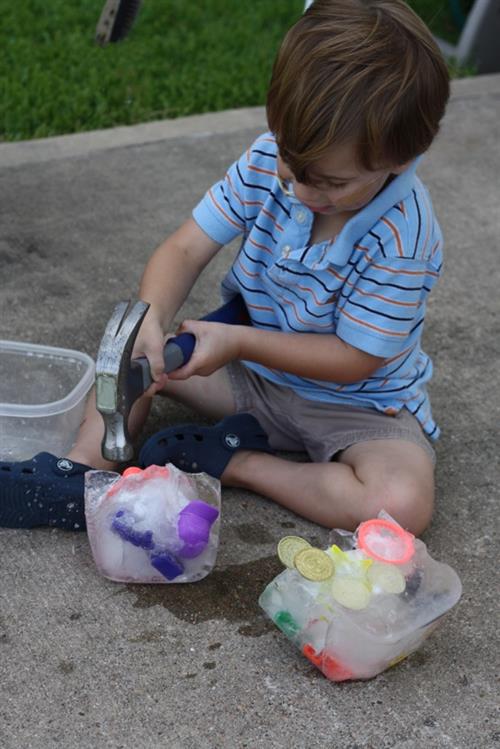
Ice excavation –
Freeze some small plastic toys (dinosaurs are perfect) in a bowl full of water. Then just pop the big ice block out, give your kiddo a hammer (a REAL one!) and let them try to “rescue” the toys from the ice. Add a few shakes of salt and see how the ice reacts.
Sensory Sand –- sand
- shaving cream
- bucket
- shovel or mixing spoon
Fill a bucket, bowl, or bin with sand. Add a generous amount of shaving cream to the sand. Mix together until light and fluffy and whipped like foam. Great fun to drive cars and trucks through. Clean-up is easy when done by playing, simply hose off the toys and kiddos.
Ice Volcano –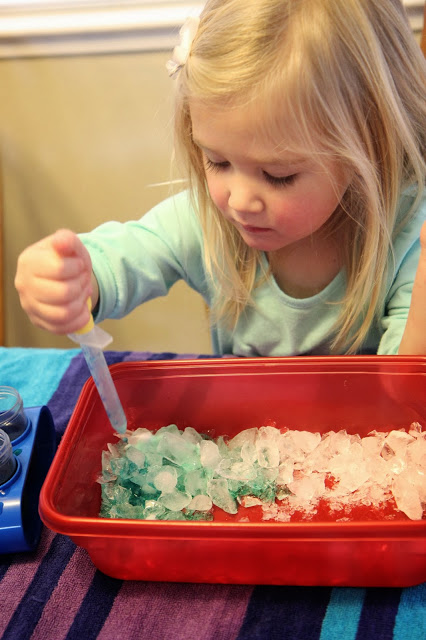
- crushed or cubed pieces of ice in a bowl or bucket
- vinegar
- food coloring
- medicine dropper
- baking soda
Mix vinegar and food coloring to make colored vinegar and put it in your test tubes or little cups where they are easily accessible.
Next, fill up a bucket with crushed or cubed ice and work to build mounds or piles of ice. Then, add some baking soda to the mound and put some more ice on top of it.
Watch the reactions and chat with your kids about what they see! Pick a new color to drop and add that to the ice again. Add more baking soda to the ice and drop more vinegar onto the mounds and make even more observations.
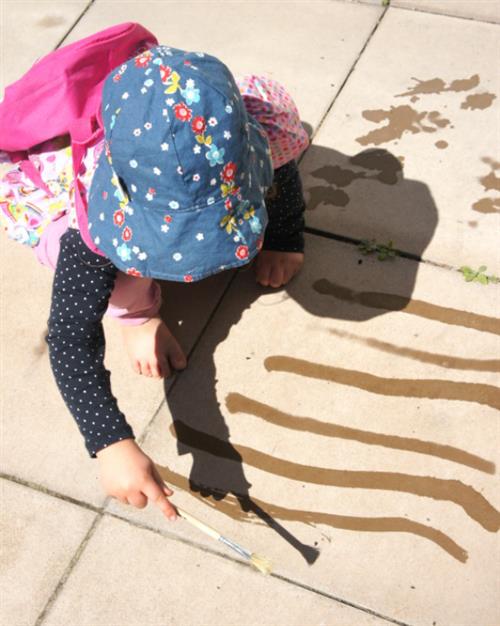 Painting with water –
Painting with water – - Water
- Ice cube
- Container
- Paintbrush
Water painting is a great way to keep your little ones busy. Fill a bucket with water and give your child a clean paintbrush. They can paint the deck, driveway, or house – no damage and it’s fun to see their “paintings”.
Tongs and water play –
Your little one will love being outside and playing with water all summer. Adding a few toys and tongs helps them with their fine motor development as they work to grab small objects and move them between buckets.
- tongs (various sizes)
- 2 big bowls or buckets
- foam blocks or small toys – things that float and sink (also fun with ice cubes in water)
Fill bowls or buckets with water and add toys. Let your child add the toys to the water, and talk about how some float and some sink. Then give them the tongs to grab the toys.
NOTE: Using tongs does take a little practice for a toddler…they need to first understand how the tongs work, then how much pressure to apply to squeeze them together, then how to pick up items from the water.
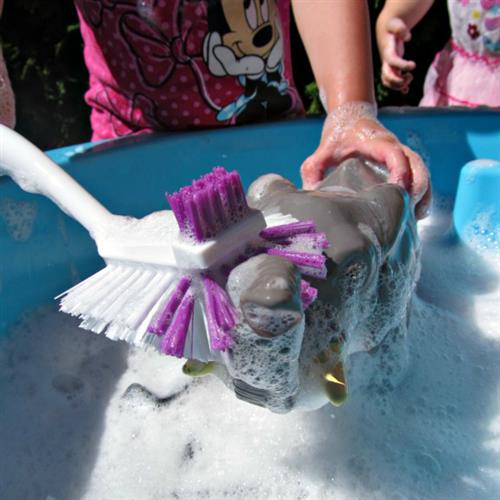 Toy washing station –
Toy washing station – - Two large buckets or bins
- Tear-free bubble bath
- Scrubbing tools
- Plastic toys that are OK to get wet
- Large towel
Fill one container with water and add some tear-free bubble bath – make it nice and bubbly. Fill the other container with just water. Have the kids add plastic toys (balls, cars, animals) to the bubbly water and give them a scrubbing brush. Once a toy is thoroughly ‘cleaned’, it can be added to the rinsing container. Finally, put the clean toys on the beach towel for drying.
How are you going to beat the heat this summer? -
Five tips on nurturing your child's mental health
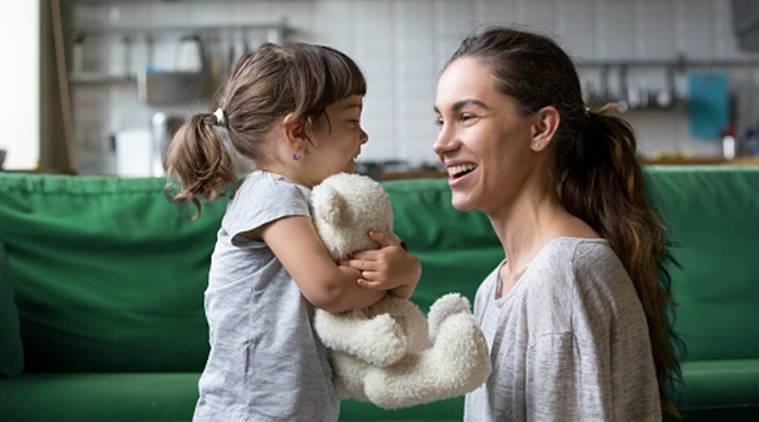 Mental health affects the way people think, feel, and act. Taking care of our mental health is just as important as having a healthy body. As a parent, you play an important role in your child's mental health:
Mental health affects the way people think, feel, and act. Taking care of our mental health is just as important as having a healthy body. As a parent, you play an important role in your child's mental health:- You can promote good mental health by the things you say and do, and through the environment you create at home.
- You can also learn about the early signs of mental health problems and know where to go for help.
How can I nurture my child’s mental health?
- Help children build strong, caring relationships:
- It’s important for children and youth to have strong relationships with family and friends. Spend some time together each night around the dinner table.
- A significant person who is consistently present in a child’s life plays a crucial role in helping them develop resilience. This person—often a parent or other family member—is someone your child spends a lot of time with and knows they can turn to when they need help.
- Show your children how to solve problems.
- Help children and youth develop self-esteem so that they feel good about themselves:
- Show lots of love and acceptance.
- Praise them when they do well. Recognize their efforts as well as what they achieve.
- Ask questions about their activities and interests.
- Help them set realistic goals.
- Listen, and respect their feelings:
- It’s OK for children and youth to feel sad or angry. Encourage them to talk about how they feel.
- Keep communication and conversation flowing by asking questions and listening to your child. Mealtime can be a good time for talking.
- Help your child find someone to talk to if they don’t feel comfortable talking to you.
- Create a safe, positive home environment:
- Be aware of your child’s media use, both the content and the amount of time spent on screens. This includes TV, movies, the Internet, and gaming devices. Be aware of who they might be interacting with on social media and online games.
- Be careful about discussing serious family issues—such as finances, marital problems, or illness—around your children. Children can worry about these things.
- Provide time for physical activity, play, and family activities.
- Be a role model by taking care of your own mental health: Talk about your feelings. Make time for things you enjoy.
- In difficult situations, help children and youth solve problems:
- Teach your child how to relax when they feel upset. This could be deep breathing, doing something calming (such as a quiet activity they enjoy), taking some time alone, or going for a walk.
- Talk about possible solutions or ideas to improve a situation and how to make it happen. Try not to take over.
Mental health disorders can prevent children and youth from succeeding in school, making friends, or becoming independent from their parents. Children and youth with mental health disorders may have trouble reaching their developmental milestones.
The good news is that mental health disorders are treatable. There are many different approaches to helping children and youth struggling with emotional or mental health problems. Contact your pediatrician for support and possible referral.
Source: University of MN Birth to Three Clinic & Early Childhood Mental Health ProgramLicensed parenting educators are happy to share parenting tips or point families in the right direction of resources available. Anoka-Hennepin Community Education provides Early Childhood Family Education (ECFE) resources for families with children ages birth to grade three, year-round.
Stay Connected!
Subscribe to emails to learn about opportunities to attend classes and activities, preschool information, and parenting tips and ideas. And, make sure to follow us on Facebook and Instagram to get the latest information, promotions, and other exciting announcements.
- You can promote good mental health by the things you say and do, and through the environment you create at home.
-
How to prepare your child for preschool
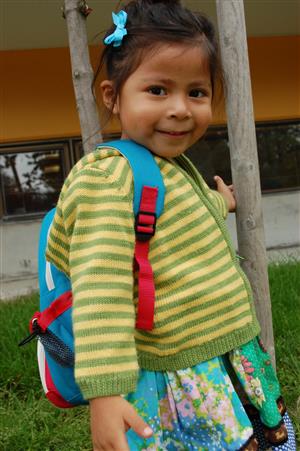 Starting preschool is one of many exciting milestones of childhood. Anoka-Hennepin Schools Preschool teachers and staff are excited to meet your child and eager to help your family make this a successful and smooth transition.
Starting preschool is one of many exciting milestones of childhood. Anoka-Hennepin Schools Preschool teachers and staff are excited to meet your child and eager to help your family make this a successful and smooth transition.
Anoka-Hennepin Schools Preschool teachers share with families that when you take the time to prepare your child and yourself, the transition can go smoothly for your whole family. Keep your efforts low-key. If you make too big a deal out of this milestone, your child may end up being more worried than excited. Here are some ideas to help your young student prepare for a successful year in preschool:- Start bedtime and morning/afternoon routines a few weeks before school starts to give your child time to adapt to the new routines.
- Read stories about going to school to help your child gain confidence and information about the new experience. Talk about the changes that school will bring to your child’s typical daily routines.
- Drive by your child’s preschool site so it becomes a familiar place. Talk about the fun experiences your child will have at preschool.
- Let your child help get ready for the first day of school by choosing which clothes to wear and what backpack to use during the school year.
- Approach the year with confidence, so your child will, too. Listen if your child has doubts or fears. Talk with the classroom teaching staff if you have concerns.
- Always say goodbye when you leave and assure your child that you will be there when school is over. A family photo in your child’s pocket or a small, familiar object from home can help your child feel connected to you and more comfortable with separation.
These tips are also great to keep in mind and practice whether dropping your child off at a daycare or with a family member or friend who is lending a hand. Setting routines and expectations early helps instill school readiness skills in toddlers or even babies well before preschool.
Finally, remember the importance of attending your child’s preschool open house. Going to the open house is an important step in helping preschoolers feel comfortable in the classroom. When your child sees you talking with the teaching staff and being in their new classroom with them, it helps them feel more comfortable and ready to start their first day on their own.
Learn more about the Anoka-Hennepin Schools Preschool program, and register online.
-
Kindergarten preparation videos
Do you have a child who will soon be entering kindergarten at Anoka-Hennepin Schools?
We're excited and ready to meet your child and your family - is your child ready for school?Anoka-Hennepin Schools Preschool and elementary school teaching staff created a series of short videos to help families learn how to support school readiness in young children. Watch the kindergaten preparation videos on the school district's YouTube channel.- Video #1: Demonstrating independence
- Video #2: Exploring and using numbers
- Video #3: Holding and using markers
- Video #4: Showing an interest in books and reading
- Video #5: Upper and lower case letters
- Video #6: Word variety
- Video #7: Working and playing
-
Little hands can do big things
 Last Friday, we wrapped up our celebration of Week of the Young Child. At Riverview Early Childhood Center in Brooklyn Park, ECFE families worked together to make this beautiful reminder - Little Hands can do Big Things in the World!
Last Friday, we wrapped up our celebration of Week of the Young Child. At Riverview Early Childhood Center in Brooklyn Park, ECFE families worked together to make this beautiful reminder - Little Hands can do Big Things in the World!
Create your own beautiful reminder with your little ones. Download a template now.
-
Manage yourself so you can stay calm and loving with your child.
Remember that the holidays aren't just stressful for you, they're actually stressful for children. Children depend on the adults in their lives, both to regulate their environment, and to help them regulate their moods. If you’re out of balance, you won’t be able to help your kids stay on an even keel. In fact, if you’re anxious about everything you have to get done, your child will likely begin to act out.
Your children don’t need a magazine-spread holiday. They need you to live the spirit of the season and spread love and good cheer. Here's how.- Give up on perfection and accept that real parents get holidays (maybe something like) filled with real-life, complete with messy kitchens, cranky kids, and events that you can't get to because somebody needs a nap.
- Cut back your schedule to do only the essentials. Just say 'no' to whatever doesn’t bring you joy.
- Make sure you nurture yourself and stay in balance. Start by getting enough sleep.
- Focus on family connections above all else.
- Just say 'no' to comparing yourself to anyone else. You can't see inside their family; you can only do what seems right for your family at this moment, and that is more than enough.
- Be sure your own expectations of the season are reasonable.
- The minute your mood veers from loving to frenzied, stop. Hug your children and regroup.
- Count your blessings and say 'thank you' for everything good in your life, every day.
- Find ways to laugh at what will inevitably go wrong.
- Pat yourself on the back and congratulate yourself on a job well done, not just in December, but all year long.
So, no matter what December holiday you celebrate, it isn't about making cookies to post on Instagram. It's about filling your home with the real meaning of your holiday by focusing on presence, instead of presents. This means keeping your own cup full, so you can be emotionally generous in filling everyone else's.Adapted from Aha Parenting - Parents' Holiday Survival Skill #1: Manage Yourself
-
Postpartum helpful links
 Postpartum depression (PPD) is a condition that takes many forms and can remain undiagnosed for long periods of time.
Postpartum depression (PPD) is a condition that takes many forms and can remain undiagnosed for long periods of time.- Approximately 70% to 80% of women will experience some form of the ‘baby blues'.
- One recent study found that 1 in 7 women may be diagnosed with postpartum depression in the year after giving birth.
- As with all forms of mental health conditions, early recognition and treatment of postpartum depression can lead to better symptom management and faster recovery rates.
Immediate Support
- Mental Health Crisis Texting (24-hours a day)
- Text MN to 742741
- National Suicide Prevention Lifeline:
- 1-800-273-8255
- 1-888-628-9454
Nacional de Prevención del Suicidio
- Suicide Prevention Hotline:
- 1-800-SUICIDE
- National Postpartum Depression Warmline:
- 1-800-PPD-MOMS
Additional Information & Support for Perinatal Depression/Anxiety
- Pregnancy & Postpartum Support Minnesota
:
- (612) 787-PPSM or (612) 787-7776
- Mother-Baby HopeLine at Hennepin Healthcare:
- (612) 873-HOPE or (612) 873-4673
- Postpartum Depression
- Postpartum Men
- Postpartum Progress
-
Potty training tips
The simple truth about potty training is that if the child is ready, it can happen very easily. If not, a power struggle may begin -- and no one wins a parent-child power struggle.
Moving from diapers to using the toilet independently is a natural process. Set up conditions so your child can learn. Your goal is to make it as easy and effortless as possible. Think of this as a process of learning that unfolds over time, like all other learning and mastery.
Here are a few tips for potty training from Parenting Educator, Kari Kurtz.- Educate your child - Teach them about the process by reading children's books, letting them watch you use the potty, and talking about the steps. Change their diapers in the bathroom, dump their poop in the toilet and let them flush it down to show them where it belongs. All of these steps will help them get familiar with the process for when they are ready to begin.
- Look for readiness signs - Watch for signs like hiding to poop, disliking wet or soiled diapers, wanting to please adults, ability to pull pants up and down, staying dry longer, wanting to use the potty. The more readiness signs your child has, the quicker the potty training process will go.
- Let your child lead - Ask your child if they want to sit on the potty each time you change their diaper. If they say no, agree without argument. Instead of forcing your child to sit on the potty, give them choices and let them know that when they are ready, they can try. This can eliminate power struggles and future constipation issues.
- Praise efforts - Praise your child for all efforts of the potty training process. You decide whether you want to use incentives or rewards, but overall keep it positive and let your child know that you are proud of them in any step they take. Be patient with potty accidents and let your child know they will have another chance next time.
- Make it comfortable - Potty training can sometimes be a scary and worrisome experience for children. Offer lots of possible ways to get comfortable- a potty seat, a child-size potty, or a kid-size urinal. Take the potty chair along with you in the car for ease as you begin or put some sticky notes in your diaper bag to put over the flush sensor in public bathrooms. These will eliminate any bad experiences in public that might create setbacks.
- Know that it will happen - Be assured that your child will be using the toilet independently before kindergarten! The average age of being toilet trained for boys is 3 1/2 and 2 1/2 for girls. Your child will do it when they are confident and ready!
As you consider your potty training options, remember that each child is different. Choose potty training techniques that you feel comfortable with, and don’t hesitate to drop techniques that seem to upset your child.
- Educate your child - Teach them about the process by reading children's books, letting them watch you use the potty, and talking about the steps. Change their diapers in the bathroom, dump their poop in the toilet and let them flush it down to show them where it belongs. All of these steps will help them get familiar with the process for when they are ready to begin.
-
Practice math and science...cook with your kids!
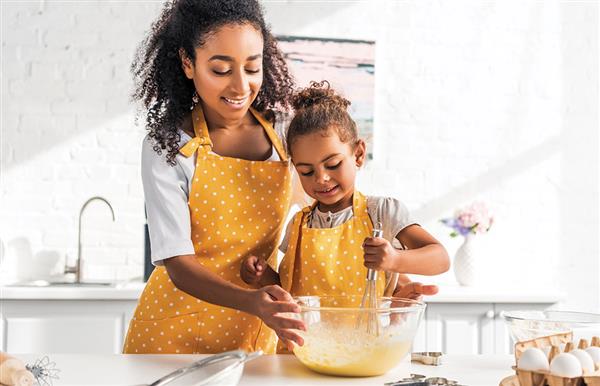 See how tasty science can be when you try a couple of new recipes with your kids - no-fail bread in a bag, pancake poppers, or no-cook PB&J tacos. Practicing following directions and measuring ingredients helps children learn important math skills and science concepts.
See how tasty science can be when you try a couple of new recipes with your kids - no-fail bread in a bag, pancake poppers, or no-cook PB&J tacos. Practicing following directions and measuring ingredients helps children learn important math skills and science concepts.
Bread in a BagWhat you’ll need:
Mini loaf pans (foil pans)Resealable plastic bag (1 gallon)Cooking spray, for mini loaf pans3 c. all-purpose flour, divided1/4 c. sugar1 .25-package active dry yeast1 c. warm water3 tbsp. extra-virgin olive oil2 tsp. saltDirections:- Preheat the oven to 375º and spray mini loaf pans with cooking spray. In a zippered plastic bag, place 1 cup flour, sugar, yeast and add warm water.
- Seal the bag and squish together with your hands to mix. Let rest 10 minutes at room temperature. (yeast should activate.) Add 1 cup flour, oil, and salt to the bag, then seal and squish together.
- Add the remaining cup of flour and mix until combined. Remove from the bag and knead for 5 minutes until smooth. Halve the dough and place it in two loaf pans. Cover with a kitchen towel and let rise 30 minutes.
- Brush the top of the bread with olive oil or melted butter and bake until golden, about 30 minutes.
Pancake PoppersWhat you’ll need:
Mini muffin pan
Cooking spray
1 1/2 c. flour
2 tbsp. sugar
2 1/2 tsp. baking powder
1 tsp. baking soda
1/2 tsp. salt
3/4 c. milk
2 tbsp. maple syrup
2 tbsp. butter, melted
1 egg, lightly whisked
1 tsp. vanilla extract
1/2 tsp. ground cinnamon
Directions:- Preheat the oven to 400 degrees F. Spray a mini muffin pan with cooking spray.
- In a large bowl, stir together flour, sugar, baking powder, baking soda, and salt. Then stir in milk, maple syrup, butter, egg, vanilla, and cinnamon. Fold in mini chocolate chips until just combined. Divide the batter evenly between mini muffin cups.
- Bake for 8-10 minutes. Serve warm or at room temperature, with maple syrup.
PB&J TacosWhat you’ll need:
4 slices bread1/3 c. peanut butter (or other nut butter)1/3 c. jelly1/2 c. chopped strawberries1/2 c. blueberries1/4 c. crushed graham crackersHoney, for drizzling
Directions:- Using a large glass or biscuit cutter, cut the bread into rounds and discard the crust (or feed it to the birds).
- Spread peanut butter (or other nut butter) to the edges of each bread round. Repeat with jelly, then sprinkle with strawberries, blueberries, and graham crackers.
- Drizzle with honey, fold like a taco and serve.
Source: Delish.com
-
Pregnancy and infant loss resources
 Annually, October 15, marks Pregnancy and Infant Loss Awareness Day, and October as a month is set aside to bring awareness to the families whose lives are forever altered by the death of their children during pregnancy, birth, or in infancy. We are taking this time to remember, support, and surround the one in four people who have experienced this heartbreak.
Annually, October 15, marks Pregnancy and Infant Loss Awareness Day, and October as a month is set aside to bring awareness to the families whose lives are forever altered by the death of their children during pregnancy, birth, or in infancy. We are taking this time to remember, support, and surround the one in four people who have experienced this heartbreak. The loss of a child stays with parents, friends, and family members forever, but it can be challenging for others to truly understand the emotional and physical impact. We have gathered some local and national resources to share.
Immediate support
- Crisis Intervention Assessment (Mercy Hospital): 763-236-7911
- National Postpartum Depression Warmline: 1-800-PPD-MOMS
Additional information and support
- Pregnancy & Infant Loss Support Minnesota
- Missing Grace Foundation
- Pregnancy & Infant Loss Group- Maple Grove
- Grief Support – North Metro Coalition - 763-413-2985
- Star Legacy Foundation
- Shoshana Center
- IRIS
- Faith's Lodge
- National Share
- Pregnancy After Loss Support
- Return to Zero Healing Center
-
Ten tips for teaching and talking to kids about race
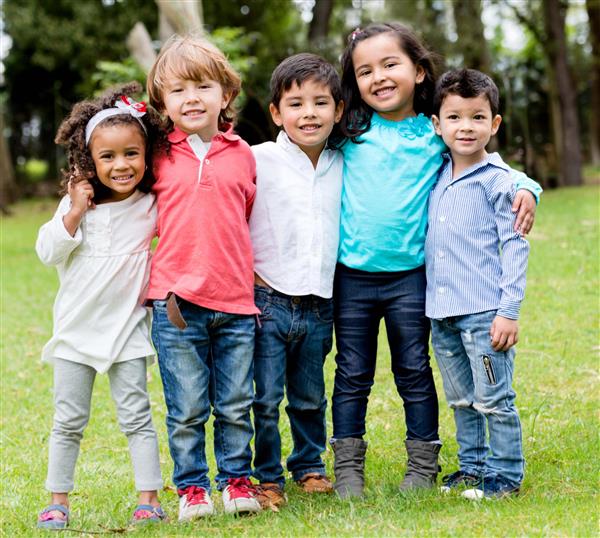 Parents of all backgrounds can talk to and guide their children about race early and often by lifting up age-appropriate activities that can be incorporated into their daily lives. We hope these tips provide some support for families committed to building tolerance, racial equity, and a social culture where all kids and families can thrive.
Parents of all backgrounds can talk to and guide their children about race early and often by lifting up age-appropriate activities that can be incorporated into their daily lives. We hope these tips provide some support for families committed to building tolerance, racial equity, and a social culture where all kids and families can thrive.1. Start early.
- By six months of age, babies notice racial differences. By age four, children have begun to show signs of racial bias.
- Let your child know that it’s perfectly okay to notice skin color and talk about race. Start talking about what racial differences mean and don’t mean.
2. Encourage your child.
- Encourage your child to ask questions, share observations and experiences, and be respectfully curious about race.
- Expose your child to different cultural opportunities – photographs, films, books, or cultural events, for example – and discuss the experience afterward.
- You don’t have to be an expert on race to talk about it with your child. Be honest about what you don’t know and work with your child to find accurate information.
3. Be mindful.
- What kids hear from us is less important than what they see us do.
- You are a role model to your child. What you say is important, but what you do - the diversity of your friendship circle, for example - is likely to have a bigger impact.
- If you do not live in a diverse community, choose books and toys that include people of different races and ethnicities. Visit museums with exhibits about a range of cultures and religions.
4. Face and know your own bias.
- Let your child see you acknowledge and face your own biases.
- We’re less likely to pass on the biases we identify and work to overcome.
- Give your child an example of a bias, racial or otherwise, that you hold or have held. Share with the child things you do to confront and overcome that bias.
5. Know and love who you are.
- Talk about the histories and experiences of the racial, ethnic, and cultural groups that you and your family identify with. Talk about their contributions and acknowledge the less flattering parts of those histories as well.
- Tell stories about the challenges that your family (your child’s parents, aunts and uncles, grandparents and great-grandparents, others) has faced and overcome.
6. Develop racial-cultural literacy.
- Develop racial-cultural literacy by learning about and respecting others.
- Study and talk about the histories and experiences of groups we call African Americans, Latinos, Asian Americans, Native Americans, and whites, among others.
- Be sure your child understands that every racial and ethnic group includes people who believe different things and behave in different ways. There is as much diversity within racial groups as across them.
7. Be honest.
- Be honest with your child, in age-appropriate ways, about bigotry and oppression.
- Children are amazing at noticing patterns, including racial patterns (who lives in their neighborhood versus their friends' neighborhoods, for example). Help them make sense of those patterns and recognize that bigotry and oppression are sometimes a big part of those explanations.
- Be sure your child knows that the struggle for racial fairness is still happening and that your family can take part in that struggle.
8. Tell stories.
- "Lift up the freedom fighters," and tell stories of resistance and resilience.
- Every big story of racial oppression is also a story about people fighting back and "speaking truth to power." Teach your child those parts of the story, too.
- Include women, children, and young adults among the "freedom fighters" in the stories you tell. A story about the racial struggle in which all the heroes are men leaves many people out.
9. Be active.
- Be active - don't be a "bystander" on race.
- Help your child understand what it means to be, and how to be, a change agent.
- Whenever possible, connect the conversations you're having to the change you and your child want to see, and to ways to bring about that change.
10. Plan for a marathon, not a sprint.
- It's okay to say, "I'm not sure" or, "Let's come back to that later, okay?" Then, do come back to it.
- Make race discussions with your child a routine. Race is a topic you should plan to revisit again and again in many different ways, over time.
Source: https://www.embracerace.org/resources/teaching-and-talking-to-kids
Licensed parenting educators are happy to share parenting tips or point families in the right direction of resources available. Anoka-Hennepin Community Education provides Early Childhood Family Education (ECFE) resources for families with children from birth to grade three, year-round.
Stay Connected!
Subscribe to emails to learn about opportunities to attend classes and activities, preschool information, and parenting tips and ideas. And, make sure to follow us on Facebook and Instagram to get the latest information, promotions, and other exciting announcements.
-
Three things to remember when your child has a bad day
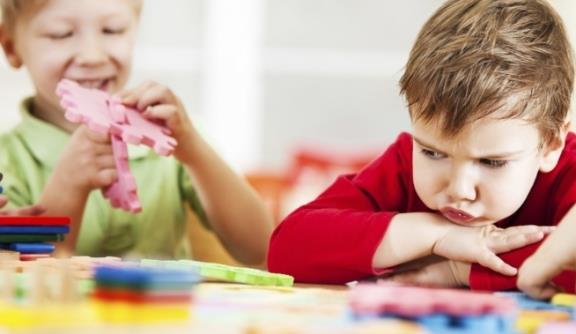 Here are three tips to help you navigate the tough situations that come along with bad days.
Here are three tips to help you navigate the tough situations that come along with bad days. 1. All behavior is communication.
First, all behavior is communication. Maybe your child is frustrated. Or tired. Or overstimulated. Maybe they are mad. Or lonely or scared.
Just like Alexander in the classic children’s book, they may be having a terrible, horrible, no good, very bad day.
Children oftentimes are not able to tell you exactly what’s going on, but their behavior can make it clear that something’s up and, as their parent/caregiver, you need to try to figure out what it is.
2. Stay calm.
Try to stay calm. Not sure how to stay calm? Try pushing a pause button and step away from the situation for a moment.
You could escalate the situation and yell, or you can deescalate the situation and come to it with calmness. And since you are the adult in the relationship, it’s your job to choose to deescalate.
Your two- or three- or four-year-old definitely won’t do it. They have no clue how to. And at this point, they probably wouldn’t, even if they could.
3. Their behavior isn’t a reflection of you
Try to remember, that when your child acts out it is not a reflection of you or your parenting skills. They’re just having a bad day. And we all have bad days, so it’s okay.
Their behavior is a reflection of their mood, their emotions, and their maturity. Your response is a reflection of your mood and your emotions.
None of us are perfect, there will be times when we don’t react how we may have liked. Own it, apologize and help your child learn from it. We can all have terrible, horrible, no good, very bad days.
Licensed parenting educators are happy to share parenting tips or point families in the right direction of resources available. Anoka-Hennepin Community Education provides Early Childhood Family Education (ECFE) resources for families with children from birth to grade three, year-round.
Stay Connected!
Subscribe to emails to learn about opportunities to attend classes and activities, preschool information, and parenting tips and ideas. And, make sure to follow us on Facebook and Instagram to get the latest information, promotions, and other exciting announcements.
-
Tips for better sleep
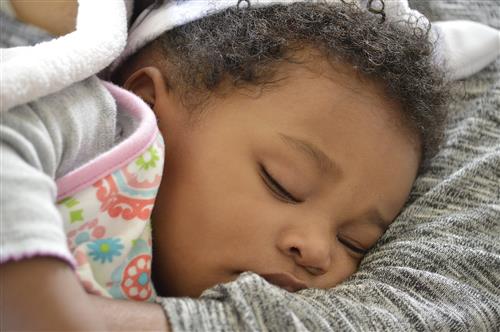 Sleep - or lack of it - is probably one of the most-discussed parenting topics in our Early Childhood Family Education (ECFE) classes. Our parenting educators share some simple strategies to put the most common bedtime problems to rest.
Sleep - or lack of it - is probably one of the most-discussed parenting topics in our Early Childhood Family Education (ECFE) classes. Our parenting educators share some simple strategies to put the most common bedtime problems to rest.- How much sleep is enough?
- Babies (birth to 6 months) need 14 to 16 hours, equally divided between day and night.
- Babies (6 to 12 months) need around 14 hours with nighttime sleep increasing.
- Toddlers (1 to 3 years) require 12 to 14 hours of sleep; daytime naps decreasing to one hour.
- Preschoolers (3 to 5 years) need 11 to 12; regular naptimes usually end around age 4.
- School-age (6-10 years) need 10-11 hours of sleep.
- Look at your daily routine. A good night’s sleep begins in the morning, with the decisions you make. Establish a regular wake time and maintain it within a 30-minute window seven days a week. Establish regular meal times. Meals set the body clock. Get outside for exposure to morning light and exercise. Establish a regular bedtime.
- Protect naps and do not wake your child from naps. A tiny toddler, less than 19 months of age, typically still needs two naps every day. The first a mere two to two and a half hours after awakening. The second about three hours after the first one ended. Older toddlers are ready to go down about four to four and a half hours after waketime. Preschoolers will last an average of five to six hours before they are ready for their nap. Miss the window for a nap and the odds are high that your child will get a second wind and not sleep.
- Know the sleep cues. There are three levels of sleep cues. Level one, red around the eyes, droopy cheeks, a glazed look is when to put babies under nine months to sleep. Level two includes the yawn, eye rub, stumble, little difficulty listening, or remembering rules – but still happy and indicates when to put down all other children. Do NOT wait for the second yawn. If your child is wild, crying, nothing is right, and can’t settle she has hit level three and is overtired. Begin your routine earlier.
- Simplify your bedtime routine so it can be completed within 20-30 minutes. Observe closely after bath and reading is your child calm or more alert? If these activities alert complete them earlier in the evening or day. A sample routine is a bedtime snack, toileting, teeth brushing, pajamas, one book, or no book, cuddle, kiss, hug, prayer if you choose, and good night. When you hit the window for sleep your child will fall asleep within 25-37 minutes. If it is taking longer, look first at your daily routine – move bedtime earlier, or later as needed.
- If your child is “wired,” slow down the routine, but maintain the steps and the order of the steps. Do not “add” more.
- If your child needs touch, such as a back rub, or you are near her, feel free to do so. Establish the limit that if she is lying down you rub her back, or lay next to her. If she gets up, you go and sit at the door. She can still see you, but for you to come back, she needs to lie down. Remove all toys from the room. Once she is settling easily you can gradually shorten the time you stay. If you choose to co-sleep and everyone sleeps well, it’s working for your family.
- Avoid electronics. The light and stimulation from electronics can trick your child’s brain into thinking this is time to be awake. Even infants and toddlers, who are not watching, are affected by the light and movement on the screen.
- Know your child’s cry. Some children do cry before falling asleep. But the cry is not one of escalating distress. Instead, it is a de-escalating, letting go. If it goes on for more than five minutes or begins to escalate go back and offer comfort.
- If your child has been falling asleep easily and suddenly is not, know this is a red flag that something is up. Stop and think about what could be causing her to feel stressed? Is she near her birthday or half birthday and going through a growth spurt? Has fighting between parents increased? If this is the case expect to provide more soothing calming for her to sleep. This is not forever; it’s for now, during this stressful time. Addressing the feelings and needs behind sleep disruption will allow your child to fall asleep peacefully.
Licensed parenting educators are happy to share parenting tips or point families in the right direction of resources available. Anoka-Hennepin Community Education provides Early Childhood Family Education (ECFE) resources for families with children from birth to grade three, year-round.
Stay Connected!
Subscribe to emails to learn about opportunities to attend classes and activities, preschool information, and parenting tips and ideas. And, make sure to follow us on Facebook and Instagram to get the latest information, promotions, and other exciting announcements.
- How much sleep is enough?
-
When bad things happen
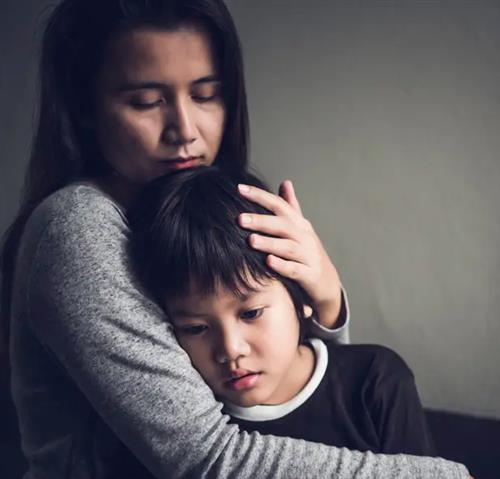 Tips for parents and caregivers on talking to kids about scary or tragic events.
Tips for parents and caregivers on talking to kids about scary or tragic events.One of the biggest challenges for parents is explaining to children about bad things that happen. An Anoka-Hennepin Schools Early Childhood Family Education Parenting Educator shares, “We cannot prevent bad things from happening or stop our children from hearing about tragic events, but how we model our reaction is key to helping children learn how to deal with these types of difficult situations throughout their entire life,”
So how do you talk to your children about violence, death, and other issues that are often difficult for even adults to handle? Our parenting educators share tips for explaining – if necessary – frightening events to young children while still making them feel safe.
It’s normal for children to be concerned. Just as adults become alarmed or even fearful, children also can feel these emotions. It is important to understand what the child has heard or knows before going into details.
Consider your own reaction. Your children will look to the way you handle difficult topics in the news to determine their own approach. If you stay calm, they will too.
Take a break from the news. While you may be interested in the latest developments, your children may not be able to handle hearing or watching the information. The American Psychological Association recommends limiting the amount of time spent watching news reports, as constant exposure may actually heighten a child’s anxiety and fears. Our parenting educators point out that it is more than just television. “In our 24/7 news culture, access to news includes the use of computers, tablets/iPads, and cell phones.”
Answer questions without unnecessary details. Even if you limit news exposure in your home, chances are your children may hear details. Ask your child what they have heard, don’t assume they know the facts. Listen to them. Acknowledge how they are feeling. Keep details to a minimum. It’s okay to say "I don’t know." We don’t always have the answers.
Do not minimize their concerns or fears. Talk to your children about the things that are being done on a daily basis to keep them safe – such as holding their hand in a parking lot or buckling them in their car seat, for example. Children oftentimes want to be told they are safe and that we do the things we need to do to protect them. Remind them that you are there for them and to come to you if they have fears.
Licensed parenting educators are happy to share parenting tips or point families in the right direction of resources available. Anoka-Hennepin Community Education provides Early Childhood Family Education (ECFE) resources for families with children from birth to grade three, year-round.
Stay Connected!
Subscribe to emails to learn about opportunities to attend classes and activities, preschool information, and parenting tips and ideas. And, make sure to follow us on Facebook and Instagram to get the latest information, promotions, and other exciting announcements.
-
Whip up a batch of cloud dough
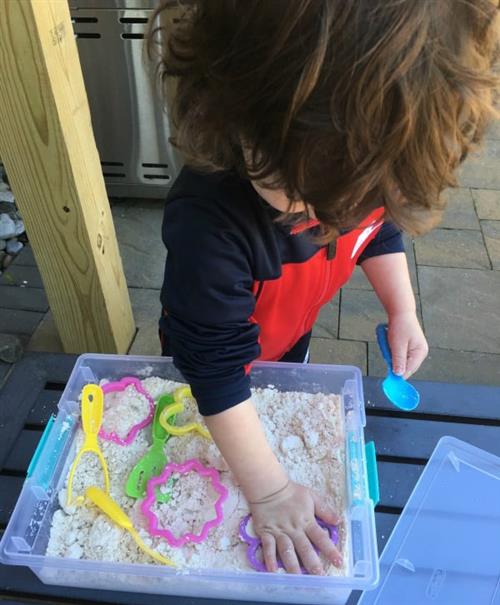 Is it easy? Yes.
Is it easy? Yes.
Is it fun? Also yes.
Is it messy? It could be. 😆
Don't let that stop you though! Cloud dough is a totally unique sensory experience that's so fun to customize. Your little ones are going to have a BLAST!
Whip up a quick batch. It's a super easy dough recipe that is perfect for hours of creative play! Download the recipe now.Stay connected and receive timely and topical parent resource information. Like us on Facebook or sign up for emails with parent resource information.
-
ContactEarly Childhood Family Education, 2727 N. Ferry St., Anoka, MN 55303
Phone: 763-506-1275
Fax: 763-506-1506
Office hours: Monday - Friday from 8 a.m. - 4 p.m.

